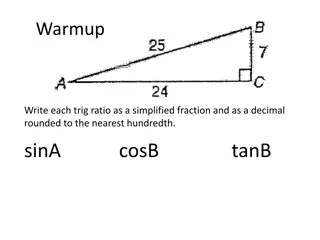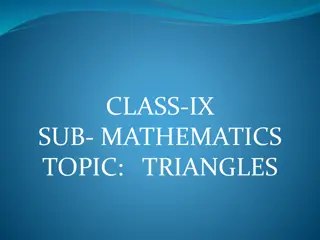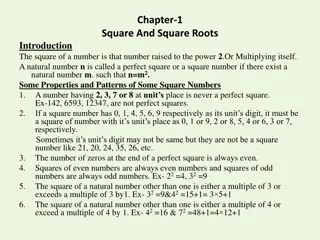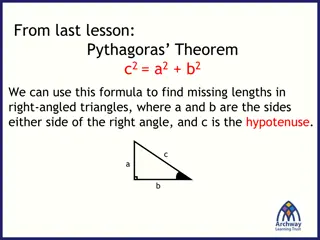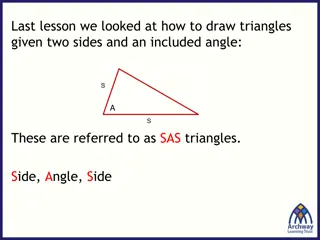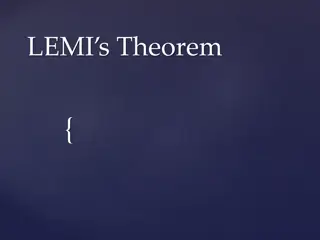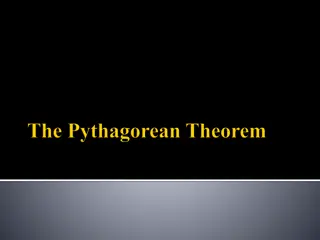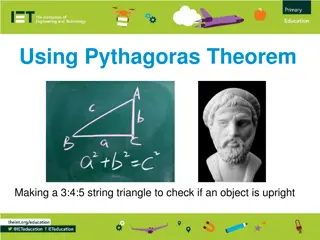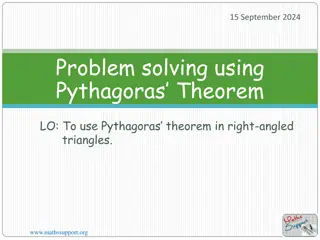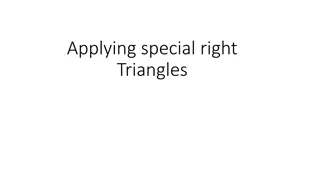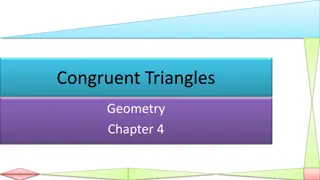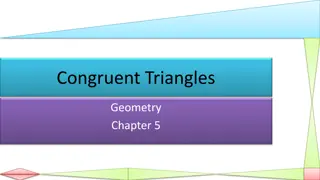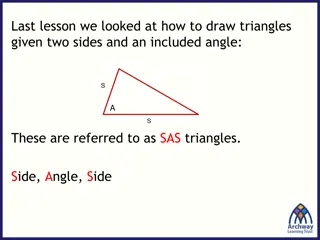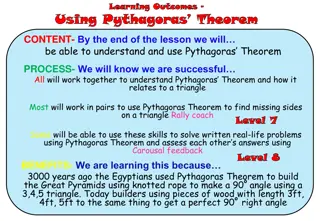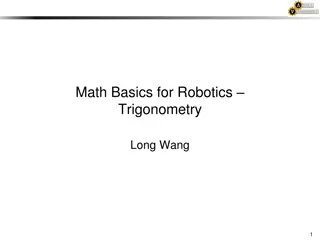Introduction to Applying Pythagorean Theorem in Right Triangles
In this lesson, we will learn how to apply the Pythagorean Theorem to find missing side lengths of right triangles. The Pythagorean Theorem states that in a right triangle, the square of the hypotenuse is equal to the sum of the squares of the other two sides. Through examples and practice problems, students will understand how to use this theorem to solve for unknown side lengths.
Download Presentation

Please find below an Image/Link to download the presentation.
The content on the website is provided AS IS for your information and personal use only. It may not be sold, licensed, or shared on other websites without obtaining consent from the author. Download presentation by click this link. If you encounter any issues during the download, it is possible that the publisher has removed the file from their server.
E N D
Presentation Transcript
1/18:We will learn to apply Pythagorean Theorem to solve for missing side lengths of right triangles. Do Now: Agenda: Homework Do Now! Have Out: - Today s Handouts - HW due today Guided Notes/Practice Handout (11 problems) IP Do Now: Be a Tri-Angel today ET
We will learn to apply Pythagorean Theorem to solve for missing side lengths of right triangles. Write down objective & begin Do Now!
The values in the chart represent the sides of a right triangle. Complete the chart below. 9 16 25 25 25 144 169 169 .36 .64 1 1 Compare the values of a2 + b2 and c2. Write an algebraic equation to represent this relationship. c2 = a2 + b2 Describe what the variables in your equation above represent by completing the following phrases: it has a box (right angle) - XYZ is a _____________ triangle because ___________________________________________________________ right they form the right angle of the triangle - a and brepresent the _____________ of XYZ because ________________________________________________ LEGS it is opposite the right angle of the triangle - crepresents the __________________ of XYZ because ________________________________________________ HYPOTENUSE
RIGHT Pythagorean Theorem: If a triangle is a _____________ triangle, HYPOTENUSE then the square of the longest side (______________) is equal to the LEGS ____________of the squares of the other two sides (__________). SUM OR
Example 1a Find the value of x. Write your answer in simplest radical form and as a decimal rounded to nearest hundredth. SOLUTION (hypotenuse)2 = (leg)2+ (leg)2 Pythagorean Theorem Substitute. 52 = 32 + x2 Square. Subtract 9 from both sides 25= 9 + x2 16 = x2 Find the positive square root. 4 = x
Example 1a Find the value of x. Write your answer in simplest radical form and as a decimal rounded to nearest hundredth. SOLUTION Not possible because not a right triangle
Example 1c Find the value of x. Write your answer in simplest radical form and as a decimal rounded to nearest hundredth. SOLUTION 2 (hypotenuse)2 = (leg)2+ (leg)2 Pythagorean Theorem Substitute. Square. Add. x2 = 4 + 12 x2 = 16 x = 4 Find the positive square root.
Example 1c Maritza and Melanie run 8 miles north and then 5 miles west. What is the shortest distance, to the nearest hundredth of a mile, they must travel to return to their starting point?
EXAMPLE 4 SOLUTION = + 162 = 42 + x2
EXAMPLE 3 Standardized Test Practice SOLUTION 162 = 42 + x2 Substitute. 256 = 16 + x2 Square. 240 = x2 Subtract 16 from each side. Find positive square root. 240 = x Approximate with a calculator. 15.491 x ANSWER The ladder is resting against the house at about 15.5 feet above the ground. The correct answer is D.
Example 4 SOLUTION (hypotenuse)2 ? (leg)2+ (leg)2 Pythagorean Theorem Substitute. Square Add. 64 ?16 + 48 64 ?64 64 = 64 YES, these side lengths make a right triangle!
three whole Pythagorean Triples: Any set of _____ ____________ numbers {a, b, c} that satisfies _______________. IF it satisfies the rule stated above, then the three numbers create a _______ ____________. right triangle c2 = a2 + b2 Example 5: Determine if the following sets of numbers are Pythagorean Triples. Justify your response.
Example 5: Determine if the following sets of numbers are Pythagorean Triples. Justify your response. b. {7, 9, 8} c. {37, 12, 35} c2 ? a2 + b2 372? 122 + 352 c2 ? a2 + b2 92? 72 + 82 81? 49 + 64 1369 ? 144 + 1225 1369 = 1369 81 < 113 Since c2 = a2 + b2then this set of numbers is a Pythagorean Triple Since c2< a2 + b2then this set of numbers is NOT a Pythagorean Triple



